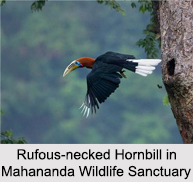 Mahananda Wildlife Sanctuary is located on the foothills of the Himalayas sited between Teesta and the Mahananda rivers. The sanctuary owes its name Mahananda from the Mahananda River. Situated in Darjeeling District of West Bengal, it covers a little more than 158 square kilometer forest areas. In 1958, it was declared as the sanctuary to protect Royal Bengal Tiger and Gaur (Indian Bison).
Mahananda Wildlife Sanctuary is located on the foothills of the Himalayas sited between Teesta and the Mahananda rivers. The sanctuary owes its name Mahananda from the Mahananda River. Situated in Darjeeling District of West Bengal, it covers a little more than 158 square kilometer forest areas. In 1958, it was declared as the sanctuary to protect Royal Bengal Tiger and Gaur (Indian Bison).
Geography of Mahananda Wildlife Sanctuary
With Mahananda River flowing through it, the sanctuary is bounded by Teesta River in the East and Hill Cart Road leading to Darjeeling in the West. The sanctuary reaches up to a high elevation at Latpanchar in Kurseong hill.
Climate of Mahananda Wildlife Sanctuary
In winter, temperature comes below 3 ° C; where in summer it goes more than 39 ° C. But the average temperature ranges from 10 ° C to 30 ° C. Mahananda Wildlife Sanctuary belongs to heavy rainfall zone, where the time span of May to October is known as rainy session. Average annual rainfall is 300 cm.
Flora and Fauna of Mahananda Wildlife Sanctuary
The Mahananda Wildlife Sanctuary has a versatile type of forest. It varies mainly from riverine forests to dense mixed-wet forest due to the different altitude. The variation in altitude and forest types helps the existence of a large number of species of mammals, birds and reptiles. Mainly Sal, Shisu, Teak, Jarul forests are available here. Other plantations include Udal, Champ, Lali, Jarul, Gamar, Mandane, Bamboos, Ferns, Orchids, Sidha etc. There are large grassy areas as well.
 The Mahananda Wildlife Sanctuary is characterised by elephant migration route. In the monsoons and during the white winter, varieties of migratory elephants take shelters here. Hence as the darkness settles, it is hardly safe to visit this place. The sanctuary has got a tremendous importance in the forest maps of India because of a considerable number of Royal Bengal Tigers. The sanctuary is mainly reserved for Royal Bengal Tiger and Gaur (Indian Bison). Except those animals, the sanctuary is also famous for chital (spotted deer), barking deer, boar, pangolin, sambar, Rhesus monkey, Himalayan black bear, many species of lesser cat like fishing cat and jungle cat, leopard including clouded leopard, and many other smaller animals like rare mountain goat (Serow), porcupines, wild pig, civets, monitor lizards, snakes, etc.
The Mahananda Wildlife Sanctuary is characterised by elephant migration route. In the monsoons and during the white winter, varieties of migratory elephants take shelters here. Hence as the darkness settles, it is hardly safe to visit this place. The sanctuary has got a tremendous importance in the forest maps of India because of a considerable number of Royal Bengal Tigers. The sanctuary is mainly reserved for Royal Bengal Tiger and Gaur (Indian Bison). Except those animals, the sanctuary is also famous for chital (spotted deer), barking deer, boar, pangolin, sambar, Rhesus monkey, Himalayan black bear, many species of lesser cat like fishing cat and jungle cat, leopard including clouded leopard, and many other smaller animals like rare mountain goat (Serow), porcupines, wild pig, civets, monitor lizards, snakes, etc.
The Mahananda Wildlife Sanctuary is also a home for a large number of colourful feathered species. The list includes endangered species like fairy-bluebird and Himalayan pied hornbill. Among the others babblers, wagtails, bee eaters, swallows, sun birds, rollers, robins, fly catchers, swift, thrush, drongo, kites, eagles, hornbills, orioles, peacock, fouls, egrets, king fishers and wood pickers are most important species found here.
There are several open areas or glades in the sanctuary where artificial saltlicks are created. The animals come there to lick the salt. This is used as a way to fulfill the mineral requirements of the animals. Animals usually come to the glades in the morning and evening.
Tourism in Mahananda Wildlife Sanctuary
Mahananda Wildlife Sanctuary is a great place for tourists to visit and see the different types of flora and fauna. To experience the flora and fauna, several watch towers have been set up in the sanctuary area. One is in Laltong to watch the elephant migration; second one is in Gulma to watch deer, Indian bison and other animals. Third one is in Toribari for bird watching; and two other watch towers are located in Golaghat and near the bank of Mahananda River. There is a museum situated just before the entrance of the forest. In the museum, there are several bodies of the animals and their skins have been preserved to give a reflection of the flora and fauna of the forest.
Visiting Information to Mahananda Wildlife Sanctuary
The best time to visit the place is from November to April. The place is well connected to Darjeeling, Siliguri and all other towns of North Bengal. The gateway to the sanctuary is situated in Sukna near the Darjeeling-Siliguri highway. Sukna is almost 13 km from Siliguri. New Jalpaiguri and Siliguri stations are the nearest rail stations to this sanctuary; Bagdogra is the nearest airport to it.



















